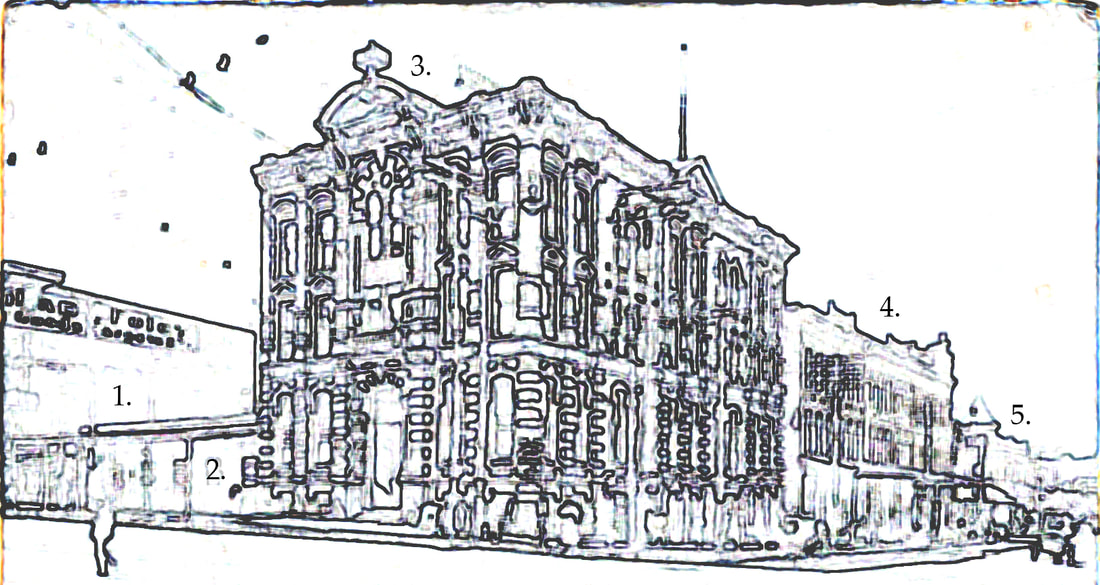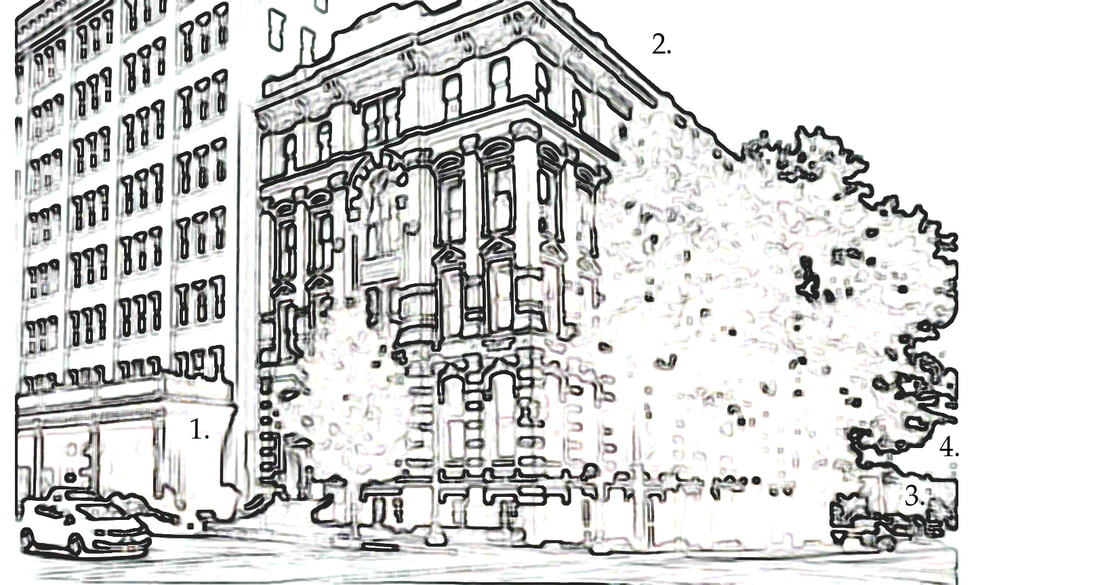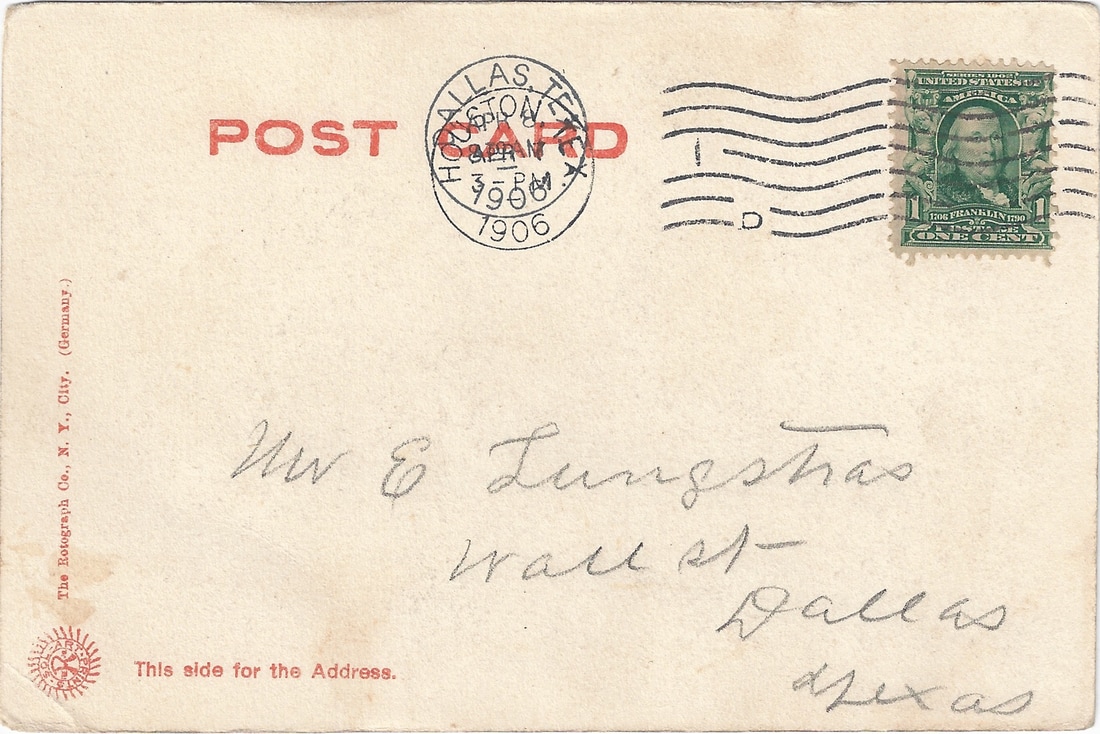Cotton Exchange
|
07 April 1906: 1. William L. Foley’s Dry Goods Store sold “dry goods, notions, millinery, ladies’ ready-to-wear goods, dressmaking, boots, shoes, furnishing goods, carpets.” William L. Foley (1855-1925), who immigrated from Ireland at age 14, was the president and his son, John Kennedy Foley (1879-1950) the secretary-treasurer. William’s nephews, Patrick C. Foley and James A. Foley, sons of his brother Thomas J. Foley, had opened their own store at 507 Main, largely financed by their uncle [See Preston - Foley Bros]. They would gradually enlarge their operation, moving to larger quarters until their great store at 1101 Main was opened in 1947; 2. The low buildings between Foley’s Dry Goods and the cotton exchange, formerly a restaurant, were removed shortly after the postcard image was taken; 3. The Cotton Exchange Building (center), designed by Eugene Heiner in the Victorian Renaissance Revival style was completed in 1885 as Houston’s very busy commercial center for cotton trading. The basement housed a plush saloon, the first floor included the exclusive Houston Club, and the second and third floors housed the exchange rooms and galleries. In 1907 the ornate top was removed, another floor was added, and the entrance moved to the left with a metal and glass marquee; 4. To the right of the Cotton Exchange was Joseph F. Meyer’s business selling iron, steel, carriages, and agricultural implements [Joseph F Meyer (1851-1935)]; 5. The two-story building with the tower across Milam Street was J. H. McEvey & Company’s well supplies [Joseph Henry Mc Evoy 1860-1929].
|
26 August 2015: 1. The 8-story Hermann Building (left) was built in 1916 to house the Hermann Estate offices, renovated in 1998 as the Hermann Lofts rental apartments. George Henry Hermann (1843-1914) was the son of John Hermann, native of Davos, Switzerland, who fought in the Battle of Waterloo. John Hermann and his wife Fannie came to Houston in 1838 when it was a fledgling settlement on Buffalo Bayou. He was a baker and dairyman who bought real estate in early Houston. George Henry Hermann served the Confederate Army in the Civil War and was in the cattle and real estate business after the war. He invested in the Humble Oil fields and after an oil strike there became immensely wealthy. At his death he left most of his fortune to the public and his legacy includes land for the Houston Museum of Fine Arts, Hermann Park, and the Memorial Hermann Hospitall; 2. The Cotton Exchange (center) was left vacant in 1924 when the Cotton Exchange was moved to larger quarters at Prairie and Caroline; the original structure was underused and became somewhat derelict, but was restored in 1973; 3-4. Surface parking lots straddling Milam Street.
|
|
Postmarked: 7 April 1906; Houston, Tex.
Stamp: 1c Blue Green Ben Franklin #300 To: Mr E. Lungstras Wall St Dallas Texas Message: M K S With best regards |
The author of the postcard signs only (M K S), and leaves the briefest of messages. It seems likely sender and recipient were not well known to each other, perhaps just participants in a postcard exchange club so prevalent in the era. The recipient, Emil Lungstras,was born 1 April 1856 in Missouri, thus just 6 days shy of his 50th birthday. He was the son of Rudolf and Frederika Lungstras, immigrants from the Rhineland near Cologne, Germany. Rudolph immigrated to America on 25 September 1852 with his 6 years widowed father Peter, brother Robert, and sister Laura on the Germanic. Other family members came later: Eugene on the St. Hermann in October, 1856, and Ewald on the Saxonia on 22 October 1858. The family settled into abundant lives in St. Louis, MO, Rudolph working as a brewer and Eugene as a clothing merchant (1870) and cloth dyer-cleaner (1880, 1900 and later). In 1854 Rudolph married his second wife, Fredericka Schmidt, who had just immigrated from Germany; 3 years later Laura married Theodore Benzen, a German immigrant from near Hamburg; in yet another 3 years Eugene married Elise Springe, who also had just immigrated from Germany. They all raised families in the area around St. Louis, MO where the German presence was significant. In 1880 its 350,000 citizens marked it as the 6th largest American city after New York, Philadelphia, Brooklyn, Chicago and Boston.
Rudolph served his new country in 1861 as a reserve infantryman for three months in the Civil War in the 1st Regiment of the US Reserve Corps, but was not involved in any military conflict. He made a good living working in the breweries, and he and Frederika raised their family mostly in St. Louis: Emil (born 1856), Salome (1858), Mathilda (1860), August (1863), Eugene (1864 in Nashville, about 60 miles east of St. Louis in Washington County, IL), Laura (1868 in Nashville as well). As a young man in St. Louis, Emil worked as a clerk in a jeans store (1880) and a buyer for a stone company (1881). In 1885 Emil married Helen Von Talkacz, daughter of veterinarian Doctor Anton Marian Von Tolkacz and Emily Marie Caroline Valeriana Eckert, immigrants from Schooner, Wielkopolskie, Poland. The Von Tolkacz family immigrated in about 1865 with 4 children: Helen (born 1858), Emil (1860), Valeria (1862), and Leon (1864). After settling in St. Louis, Mary (1868) and Elsie (1878) were added to the Tolkacz family. Emil and Helen soon moved to Dallas where he worked as a manager and bookkeeper. His children were all born in Dallas: Edith (1885), Valeria (1887), Lucy (1888), Laura (1890), Eugene (1894), and Herbert (1897). Emil took his family back to St. Louis by 1910. Emil’s son Eugene Lungstras served in the National Guard at the Mexican border in 1916 (SEE also another postcard in this series in which Murray Millard of New York posted a card of the Kiam Building [LINK] on his way through Houston to the border conflict). Eugene Lungstras married Nelly Tiernan and had a daughter, Mary Kathryn, but when she was an infant he died of Influenza on October 5, 1918 at the age of 25. Emil Lungstras died less than a year later on August 22, 1919 of a diabetic coma in St. Louis. For many years she lived with her son Herbert and her mother Emilie, who died in 1925. After a widowhood of 24 years, Helen died of heart problems in 1943. and she her mother Emilie, and her husband Emil are interred in Hilcrest Abbey Crematory and Mausoleum in St. Louis. |



